#Rocket propulsion systems
Explore tagged Tumblr posts
Text
Hydrogen Rockets: The Key to Sustainable Space Exploration
Introduction to Hydrogen Rocket Engine
In the realm of space exploration, the quest for efficient propulsion systems has led to the development and utilization of hydrogen rocket engines. These engines harness the power of hydrogen, the most abundant element in the universe, to propel spacecraft into the cosmos with remarkable efficiency and power.
History of Hydrogen Rocket Engine Development
The concept of using hydrogen as a propellant dates back to the early days of rocketry. However, it wasn't until the mid-20th century that significant advancements were made in the development of hydrogen rocket engines. Pioneering work by scientists and engineers paved the way for the modern hydrogen propulsion systems we see today.
How Hydrogen Rocket Engines Work
Fuel Combustion Process
Hydrogen rocket engines operate on the principle of combustion. Liquid hydrogen is combined with liquid oxygen in a combustion chamber, where it undergoes a controlled explosion. This rapid combustion generates intense heat and pressure, producing a powerful stream of hot gases.
Thrust Generation
The expulsion of these hot gases through a nozzle at the rear of the rocket creates thrust according to Newton's third law of motion. This thrust propels the rocket forward, overcoming the forces of gravity and atmospheric resistance.
Advantages of Hydrogen Rocket Engines
Hydrogen rocket engines offer several key advantages over conventional propulsion systems:
High Efficiency: Hydrogen boasts one of the highest specific impulse values among rocket propellants, making it extremely efficient in terms of thrust per unit of propellant mass.
Clean Combustion: The combustion of hydrogen with oxygen produces water vapor as a byproduct, resulting in cleaner emissions compared to traditional rocket fuels.
Abundant Resource: Hydrogen is abundant in the universe, making it a sustainable and readily available resource for space exploration endeavors.
Challenges and Limitations
Despite its many advantages, hydrogen rocket technology also faces significant challenges and limitations.
Cryogenic Storage
One of the primary challenges associated with hydrogen rocket engines is the need for cryogenic storage. Liquid hydrogen must be kept at extremely low temperatures to remain in a liquid state, requiring specialized storage and handling systems.
Cost and Infrastructure
The infrastructure required to produce, store, and transport liquid hydrogen adds to the overall cost of hydrogen rocket technology. Additionally, the development of hydrogen propulsion systems necessitates substantial investments in research and development.
Applications of Hydrogen Rocket Engines
Hydrogen rocket engines find a wide range of applications in space exploration and satellite deployment missions.
Space Exploration
Hydrogen-powered rockets enable spacecraft to travel vast distances across the solar system, facilitating missions to explore distant planets, moons, and celestial bodies.
Satellite Deployment
The high efficiency and reliability of hydrogen rocket engines make them ideal for launching satellites into orbit around the Earth and beyond.
Comparison with Traditional Rocket Engines
Compared to traditional rocket engines fueled by kerosene or solid propellants, hydrogen rocket engines offer superior performance and environmental benefits. They deliver higher specific impulse and produce cleaner emissions, contributing to a more sustainable approach to space exploration.
Environmental Impact and Sustainability
The environmental impact of hydrogen rocket engines is relatively minimal compared to conventional propulsion systems. The use of hydrogen as a fuel results in cleaner combustion and reduced greenhouse gas emissions, aligning with efforts to mitigate the environmental footprint of space exploration activities.
Future Prospects and Developments
As technology advances and our understanding of hydrogen propulsion deepens, the future holds great promise for hydrogen rocket engines. Ongoing research and development efforts aim to enhance efficiency, reduce costs, and overcome existing limitations, paving the way for new frontiers in space exploration.
Conclusion
Hydrogen rocket engines represent a cornerstone of modern space exploration, offering unparalleled efficiency, reliability, and environmental sustainability. While challenges remain, ongoing advancements in technology and infrastructure continue to expand the horizons of human spaceflight and scientific discovery.
FAQs
Are hydrogen rocket engines more powerful than traditional rocket engines? Hydrogen rocket engines typically offer higher specific impulse values, making them more efficient in terms of thrust per unit of propellant mass.
What are the main challenges associated with hydrogen rocket technology? Cryogenic storage and infrastructure costs are among the primary challenges facing hydrogen rocket technology.
What are the environmental benefits of hydrogen rocket engines? Hydrogen combustion produces cleaner emissions compared to traditional rocket fuels, contributing to reduced environmental impact.
What are the primary applications of hydrogen rocket engines? Hydrogen rocket engines are used in space exploration missions and satellite deployment operations.
What does the future hold for hydrogen rocket technology? Ongoing research and development efforts aim to improve efficiency, reduce costs, and expand the capabilities of hydrogen rocket engines.
#Hydrogen propulsion#Rocket engine technology#Space exploration#Liquid hydrogen#Rocket propulsion systems#Sustainable propulsion#Cryogenic storage#Spacecraft propulsion#Rocket engine efficiency#Environmental sustainability
0 notes
Text
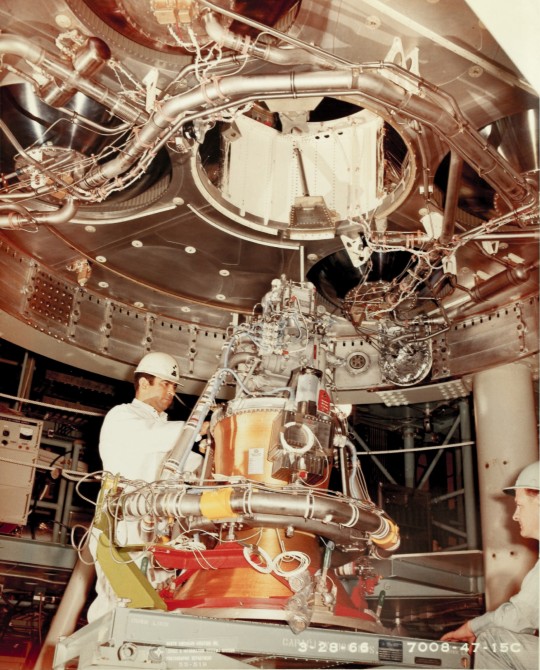

Worker installing the Aerojet AJ10-137 (Service Module Engine) on an Apollo Service Module at North American's Downey facility.
Date: March 28, 1966
SDASM Archives Casson_0023, Casson_0024
#Apollo CSM Block I#NASA#Apollo Program#Service Module Engine#Aerojet AJ10-137#Aerojet AJ10#AJ10-137#AJ10#Service Propulsion System#SPS#Rocket Engine#Construction#North American Aviation#Factory#Downey#California#March#1966#my post
63 notes
·
View notes
Text


This is Ethan Peck visiting JPL to take a look at the Europa Clipper, a spacecraft that will be launched in October towards the Jovian moon in hopes of exploring that strange new world!
Just look at how happy and nerdy he looks at JPL. Props to whoever invited him, because it's only logical to invite Mr. Spock to JPL. And props to Ethan for supporting science and exploration! I love this man 🖖🥹
#ethan peck#mr. spock#star trek#strange new worlds#Europa Clipper#JPL#Jet Propulsion Laboratory#NASA#space#the final frontier#europa#Jupiter#planets#solar system#space exploration#science#physics#astronomy#astrophysics#rocket science#spacecraft#satellite
172 notes
·
View notes
Note
Fourth option: Tails fixed the car (after all, he was able to identify what some of Knuckles' throne was made out of)
Tails fixes the car in record time but gets carried away and adds a bunch of crazy (and possibly illegal) upgrades.
#knuckles series#tails#he just wants to impress his new mom#and what kind of car lacks a rocket propulsion system??
16 notes
·
View notes
Text
Solid Rocket Motors Market: Driving Defense Sector Innovations

The Solid Rocket Motors Market is witnessing robust growth, driven significantly by the increasing demand for advanced propulsion systems in the defense sector. Solid rocket motors are essential for powering critical military applications, including missile systems and tactical defense programs. Their unique features, such as stability, high energy density, and long shelf life, make them indispensable for modern military strategies.
With a market value projected to grow from USD 6.79 billion in 2024 to USD 10.00 billion by 2029 at a CAGR of 8.1%, solid rocket motors are playing a pivotal role in shaping global defense systems. The defense sector’s reliance on these motors stems from their ability to deliver rapid thrust, reliability in extreme conditions, and immediate readiness for deployment.
The Role of Solid Rocket Motors in Modern Defense Systems
Solid rocket motors are engineered to meet the demanding requirements of advanced missile systems, such as THAAD (Terminal High Altitude Area Defense) and GMLRS (Guided Multiple Launch Rocket System). These motors are preferred for their ability to generate high thrust under various operational conditions while maintaining exceptional stability and safety.
One of the most notable advantages of solid rocket motors is their long shelf life. Unlike other propulsion systems, solid rocket motors can remain in storage for years without significant degradation in performance, making them highly effective for rapid-response scenarios. This capability is crucial for nations seeking to enhance their defense readiness amidst evolving geopolitical tensions.
Additionally, the growing focus on operator safety has increased the adoption of solid rocket motors. Their stable propellant formulations minimize handling risks, ensuring safe storage and reliable operation under critical conditions. These characteristics are vital for military programs that require precision and dependability in high-stakes missions.
Download PDF Brochure: https://www.marketsandmarkets.com/pdfdownloadNew.asp?id=161743301
Defense Programs Driving Market Growth
The increasing geopolitical tensions and shifting global security landscape have amplified the importance of solid rocket motors in defense strategies. Countries worldwide are investing heavily in missile defense systems that rely on the superior performance of solid rocket motors. For instance, programs like the Indo-Pacific Defense Strategy have highlighted the need for advanced propulsion technologies to counter emerging threats in the region.
In the United States, the National Defense Industrial Strategy has prioritized funding for solid rocket motor development. Between USD 5 million and USD 75 million is being allocated over five years to support domestic prototype production lines and establish a scalable supply chain. These investments aim to ensure the availability of reliable propulsion systems for military applications.
The strategic importance of solid rocket motors is further underscored by their use in offensive and defensive missile systems. These motors provide the thrust and accuracy needed for missiles to reach their targets with precision, ensuring mission success in complex combat scenarios. Their application extends to intercontinental ballistic missiles (ICBMs), hypersonic weapons, and naval missile systems, highlighting their versatility and indispensability in modern defense arsenals.
Meeting Defense Sector Challenges
As global defense budgets increase to address security concerns, the need for reliable and efficient propulsion systems has grown. Solid rocket motors are at the forefront of this demand, enabling nations to deploy advanced weapon systems capable of responding to evolving threats. However, this surge in demand also presents challenges, such as supply chain constraints and the high cost of development.
Supply chain management remains a critical issue in the Solid Rocket Motors Market. The limited number of suppliers for specialized materials, such as advanced composites and energetics, can create bottlenecks in production schedules. To address these challenges, leading companies like Lockheed Martin and Anduril Industries are diversifying their supplier bases and adopting innovative manufacturing techniques, such as additive manufacturing, to streamline production processes.
Another challenge lies in the high development costs associated with solid rocket motors. Precision engineering, rigorous testing, and compliance with military standards significantly drive up production expenses. While this creates barriers for smaller players, it also opens opportunities for collaborations and partnerships to overcome financial and technological hurdles.
Solid Rocket Motors as a Strategic Asset
Solid rocket motors are more than just a component of missile systems; they are a strategic asset for national security. Their ability to deliver high thrust, coupled with their reliability and simplicity, makes them a preferred choice for modern defense applications. From tactical missiles to hypersonic weapon platforms, solid rocket motors provide the propulsion power needed to achieve mission-critical objectives.
The focus on advancing solid rocket motor technologies is not limited to existing systems. Research and development efforts are driving innovations in material design and control systems, enhancing the performance, safety, and efficiency of these motors. As a result, next-generation defense systems are expected to benefit from improved propulsion capabilities, further solidifying the importance of solid rocket motors in the defense sector.
Ask for Sample Report: https://www.marketsandmarkets.com/requestsampleNew.asp?id=161743301
The Future of Solid Rocket Motors in Defense
The future of the Solid Rocket Motors Market in the defense sector looks promising, with increasing investments in advanced missile systems and propulsion technologies. Nations are prioritizing the development of cutting-edge defense systems to counter emerging threats and maintain strategic superiority.
In addition to their traditional applications, solid rocket motors are expected to play a critical role in the development of hypersonic weapons. These systems require propulsion technologies that can withstand extreme conditions while delivering exceptional performance. Solid rocket motors, with their proven track record, are well-suited to meet these requirements.
As defense strategies evolve to address new challenges, the demand for solid rocket motors will continue to rise. By investing in innovative technologies and strengthening supply chain resilience, the industry is poised to meet the growing needs of the defense sector while maintaining its position as a critical enabler of national security.
The increasing demand for solid rocket motors in the defense sector underscores their vital role in modern military applications. From providing reliable propulsion for missile systems to enabling rapid-response capabilities, these motors are indispensable for ensuring national security.
With a projected market value of USD 10.00 billion by 2029, the Solid Rocket Motors Market is on a growth trajectory fueled by advancements in defense technologies and geopolitical imperatives. By addressing challenges such as high development costs and supply chain constraints, the industry is well-positioned to capitalize on emerging opportunities and drive innovation in the defense sector.
As nations continue to prioritize defense modernization, the importance of solid rocket motors will only grow, cementing their status as a cornerstone of modern military strategies.
#solid rocket motors market#defense solid rocket motors#missile propulsion systems#military solid rocket motors#defense sector innovations
0 notes
Text
The Space Race and the Rising Demand for Advanced Rocket Propulsion Systems
Advanced Rocket & Missile Propulsion System Market: Key Trends and Growth Projections for 2024-2034

The Advanced Rocket & Missile Propulsion System Market is on the cusp of significant growth, with predictions pointing to a compound annual growth rate (CAGR) of 8.1% from 2024 to 2034. By the end of the forecast period, the market is expected to reach a staggering USD 74,976.43 million—up from USD 32,524.27 million in 2024. This impressive expansion highlights the rising demand for cutting-edge propulsion technologies in both military defense and space exploration sectors. As new propulsion technologies evolve, the market is set to see a surge in innovative applications that could transform the future of aerospace and defense.
Request Sample PDF Copy :
https://wemarketresearch.com/reports/request-free-sample-pdf/advanced-rocket-missile-propulsion-system-market/1580
The Role of Advanced Propulsion Systems
Advanced rocket and missile propulsion systems are the core drivers of space exploration, satellite launches, and military missile technology. These systems use advanced methods for propulsion, including solid, liquid, hybrid, and electric propulsion, to enable rockets and missiles to travel great distances, launch payloads into orbit, or defend against hostile threats. Whether it’s launching astronauts to space, defending national borders, or enabling satellite constellations, propulsion technology plays a crucial role.
The market for these systems includes propulsion used in launch vehicles, defense missiles, and space exploration missions. As defense budgets increase globally and space exploration efforts intensify, the demand for more efficient, cost-effective, and powerful propulsion systems continues to rise.
Key Factors Driving Market Growth
Several factors contribute to the rapid growth of the Advanced Rocket & Missile Propulsion System Market in the coming decade. These include:
Rising Military Expenditures and Security Concerns
Governments around the world are increasing defense budgets to modernize military capabilities, with a particular focus on advanced missile defense systems and hypersonic weapons. Countries like the U.S., China, and Russia are heavily investing in next-generation propulsion systems to deploy advanced missiles, including ballistic missiles, cruise missiles, and hypersonic missiles. Hypersonic missiles, capable of traveling at speeds greater than Mach 5, require highly advanced propulsion systems, further fueling the demand for cutting-edge technologies in the propulsion market.
Growth in Space Exploration and Commercial Space Ventures
The rise of private companies in the space industry, such as SpaceX, Blue Origin, and Rocket Lab, is playing a pivotal role in the demand for advanced propulsion systems. These companies, along with government space agencies like NASA and the European Space Agency (ESA), are pushing for more efficient and reusable rocket technologies. The growing number of satellite launches and space tourism ventures is increasing the need for small- and medium-lift launch vehicles, which in turn drives the demand for cost-effective propulsion systems.
In addition to traditional space missions, innovations such as satellite constellations for global communication networks, including SpaceX’s Starlink and OneWeb, are propelling the market for propulsion systems designed for frequent and reliable launches.
Technological Advancements in Propulsion Systems
The transition from conventional propulsion systems to more advanced technologies is a key market driver. Hybrid propulsion systems—combining the best aspects of liquid and solid propulsion—offer higher efficiency, better throttling, and reduced environmental impact. On the other hand, electric propulsion systems, such as ion thrusters and Hall-effect thrusters, are growing in popularity, particularly for long-duration space missions where fuel efficiency is critical. These technologies provide better performance and lower fuel consumption, making them ideal for deep space exploration.
Additionally, nuclear propulsion systems are being explored for interplanetary travel, further enhancing the future growth prospects of the market.
Market Segmentation and Key Trends
By Propulsion Type:
Chemical Propulsion: The most common and widely used technology for rocket launches and missile propulsion. This includes both liquid and solid propulsion systems.
Electric Propulsion: A more efficient, lower-thrust technology used for deep-space exploration. Electric propulsion systems, including ion and Hall-effect thrusters, are growing in demand for satellite deployment and space missions.
Hybrid Propulsion: Combining the benefits of both solid and liquid propulsion systems, hybrid systems offer greater flexibility and performance, especially for smaller launch vehicles.
Emerging Propulsion Technologies: Innovations such as nuclear thermal propulsion and advanced chemical propellants are being explored for future missions to the Moon, Mars, and beyond.
By Application:
Military & Defense: With the rising focus on missile defense systems and the development of hypersonic weapons, defense remains the dominant sector for advanced propulsion systems.
Space Exploration & Satellite Launching: The growing commercial space industry and satellite constellations are significant contributors to the demand for advanced propulsion technologies.
Commercial Space Ventures: Companies focused on space tourism, such as Virgin Galactic, and satellite deployment continue to drive the adoption of innovative propulsion systems.
By Region:
North America: The U.S. is the largest market for advanced rocket and missile propulsion systems, with a high concentration of leading defense contractors and space exploration firms.
Asia-Pacific: Countries like China and India are ramping up defense capabilities and investing in space exploration, making the Asia-Pacific region a critical market.
Europe: The European Union and ESA continue to play a crucial role in space exploration, while countries like Russia remain key players in defense and missile technologies.
Conclusion:
The Future of the Advanced Rocket & Missile Propulsion System Market
The Advanced Rocket & Missile Propulsion System Market is poised for significant growth over the next decade. Driven by increasing investments in defense and space exploration, the market is expected to expand at a CAGR of 8.1%, reaching USD 74,976.43 million by 2034. Technological innovations in propulsion systems, such as hybrid, electric, and hypersonic technologies, will continue to fuel market expansion. As the demand for more efficient, sustainable, and advanced propulsion systems grows, companies operating in this space will need to remain agile and innovative to meet the evolving needs of the aerospace and defense industries.
#Advanced Rocket Propulsion#Missile Propulsion Systems#Space Propulsion Technologies#Rocket Propulsion Market#Missile Defense Systems#Hypersonic Missile Technology
0 notes
Text
Breakthroughs in Space Technology: What’s on the Horizon?
Introduction
Space technology has always captured our imagination, pushing the boundaries of what is possible. As we venture further into the cosmos, remarkable breakthroughs are paving the way for new discoveries and advancements. In this article, TechtoIO delves into the exciting world of space technology, highlighting the latest innovations and what’s on the horizon for space exploration. Read to continue link
#Innovation Insights#Tagsadvanced propulsion systems#AI in space#colonizing other planets#commercial spaceflight#future of space technology#interstellar exploration#Mars missions#miniaturized satellites#moon missions#private space companies#radiation protection in space#reusable rockets#space debris solutions#space exploration#space technology#space technology breakthroughs#space tourism#space-based solar power#sustainable space exploration#Trends#Nvidia Drive#Analysis#Tech news#Science updates#Digital advancements#Tech trends#Science breakthroughs#Data analysis#Artificial intelligence
1 note
·
View note
Text
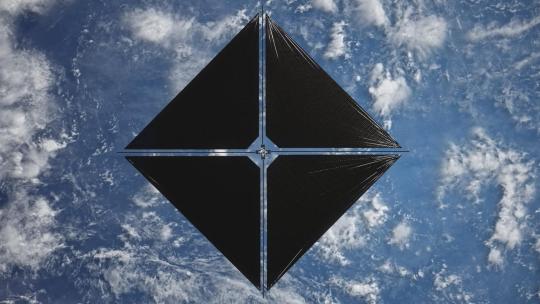
Setting Sail to Travel Through Space: 5 Things to Know about our New Mission
Our Advanced Composite Solar Sail System will launch aboard Rocket Lab’s Electron rocket from the company’s Launch Complex 1 in Māhia, New Zealand no earlier than April 23, at 6 p.m. EDT. This mission will demonstrate the use of innovative materials and structures to deploy a next-generation solar sail from a CubeSat in low Earth orbit.
Here are five things to know about this upcoming mission:
1. Sailing on Sunshine
Solar sails use the pressure of sunlight for propulsion much like sailboats harness the wind, eliminating the need for rocket fuel after the spacecraft has launched. If all goes according to plan, this technology demonstration will help us test how the solar sail shape and design work in different orbits.

2. Small Package, Big Impact
The Advanced Composite Solar Sail System spacecraft is a CubeSat the size of a microwave, but when the package inside is fully unfurled, it will measure about 860 square feet (80 square meters) which is about the size of six parking spots. Once fully deployed, it will be the biggest, functional solar sail system – capable of controlled propulsion maneuvers – to be tested in space.
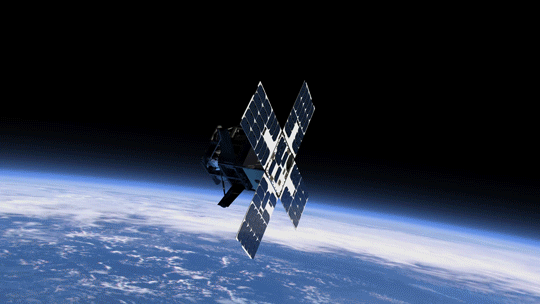
3. Second NASA Solar Sail in Space
If successful, the Advanced Composite Solar Sail System will be the second NASA solar sail to deploy in space, and not only will it be much larger, but this system will also test navigation capabilities to change the spacecraft’s orbit. This will help us gather data for future missions with even larger sails.
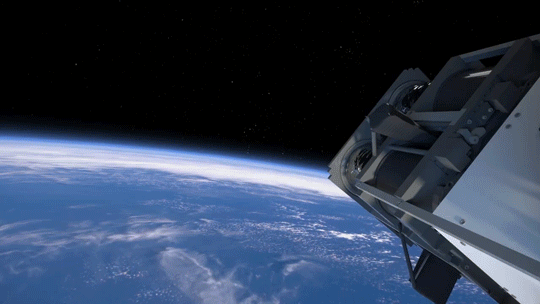
4. BOOM: Stronger, Lighter Booms
Just like a sailboat mast supports its cloth sails, a solar sail has support beams called booms that provide structure. The Advanced Composite Solar Sail System mission’s primary objective is to deploy a new type of boom. These booms are made from flexible polymer and carbon fiber materials that are stiffer and 75% lighter than previous boom designs. They can also be flattened and rolled like a tape measure. Two booms spanning the diagonal of the square (23 feet or about 7 meters in length) could be rolled up and fit into the palm of your hand!

5. It’s a bird...it’s a plane...it’s our solar sail!
About one to two months after launch, the Advanced Composite Solar Sail System spacecraft will deploy its booms and unfurl its solar sail. Because of its large size and reflective material, the spacecraft may be visible from Earth with the naked eye if the lighting conditions and orientation are just right!
To learn more about this mission that will inform future space travel and expand our understanding of our Sun and solar system, visit https://www.nasa.gov/mission/acs3/.
Make sure to follow us on Tumblr for your regular dose of space!
2K notes
·
View notes
Text
Mariner program
The Mariner program was conducted by the American space agency NASA to explore other planets. Between 1962 and late 1973, NASA's Jet Propulsion Laboratory (JPL) designed and built 10 robotic interplanetary probes named Mariner to explore the inner Solar System - visiting the planets Venus, Mars and Mercury for the first time, and returning to Venus and Mars for additional close observations.
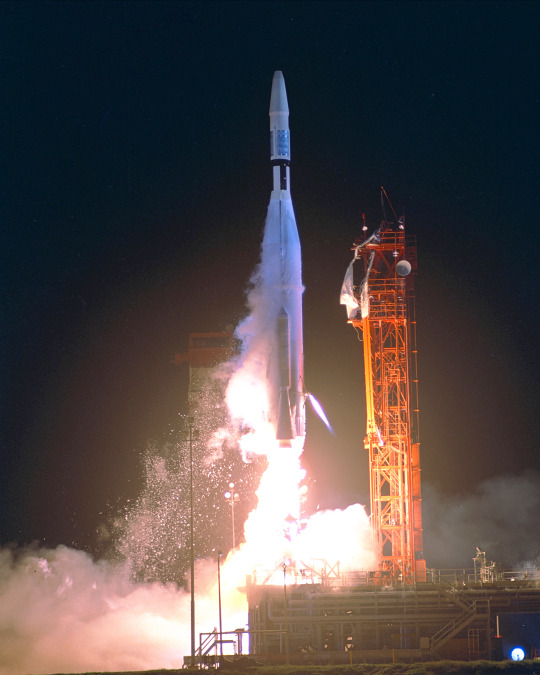
The program included a number of interplanetary firsts, including the first planetary flyby, the planetary orbiter, and the first gravity assist maneuver. Of the 10 vehicles in the Mariner series, seven were successful, forming the starting point for many subsequent NASA/JPL space probe programs.

The name of the Mariner program was decided in "May 1960-at the suggestion of Edgar M. Cortright" to have the "planetary mission probes ... patterned after nautical terms, to convey 'the impression of travel to great distances and remote lands.'" That "decision was the basis for naming Mariner, Ranger, Surveyor, and Viking probes."
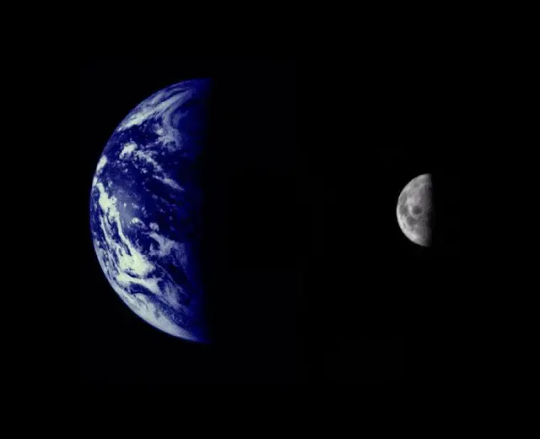
Each spacecraft was to carry solar panels that would be pointed toward the Sun and a dish antenna that would be pointed at Earth. Each would also carry a host of scientific instruments. Some of the instruments, such as cameras, would need to be pointed at the target body it was studying. Other instruments were non-directional and studied phenomena such as magnetic fields and charged particles. JPL engineers proposed to make the Mariners "three-axis-stabilized," meaning that unlike other space probes they would not spin.
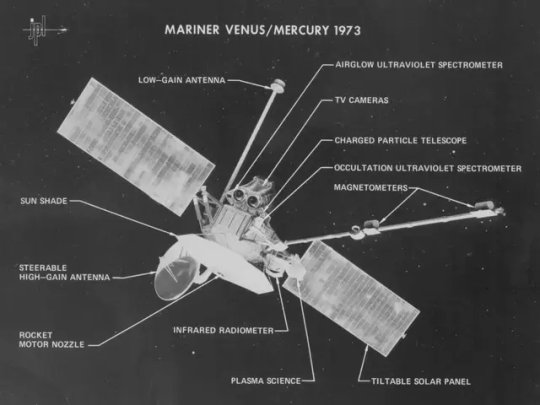
Mariner 1 and Mariner 2
Mariner 1 and Mariner 2 were two deep-space probes making up NASA's Mariner-R project. The primary goal of the project was to develop and launch two spacecraft sequentially to the near vicinity of Venus, receive communications from the spacecraft and to perform radiometric temperature measurements of the planet. A secondary objective was to make interplanetary magnetic field and/or particle measurements on the way to, and in the vicinity of, Venus.
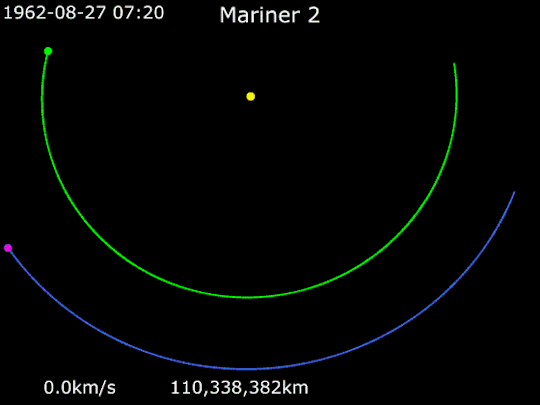
Animation of Mariner 2's trajectory from August 27, 1962, to December 31, 1962. Mariner 2 · Venus · Earth.
Mariners 3 and 4
Sisterships Mariner 3 and Mariner 4 were Mars flyby missions.
Mariner 3 was launched on November 5, 1964, but the shroud encasing the spacecraft atop its rocket failed to open properly and Mariner 3 did not get to Mars.
Mariner 4, launched on November 28, 1964, was the first successful flyby of the planet Mars and gave the first glimpse of Mars at close range
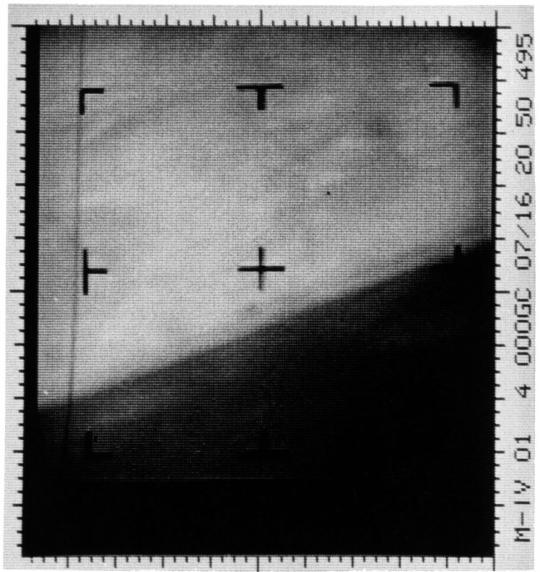
This archival image is an enhanced contrast version of the first Mars photograph released on July 15, 1965. This is man's first close-up photograph of another planet -- a photographic representation of digital data radioed from Mars by the Mariner 4 spacecraft. Data was either sent to Earth immediately for acquisition or stored on an onboard tape recorder for later transmission.
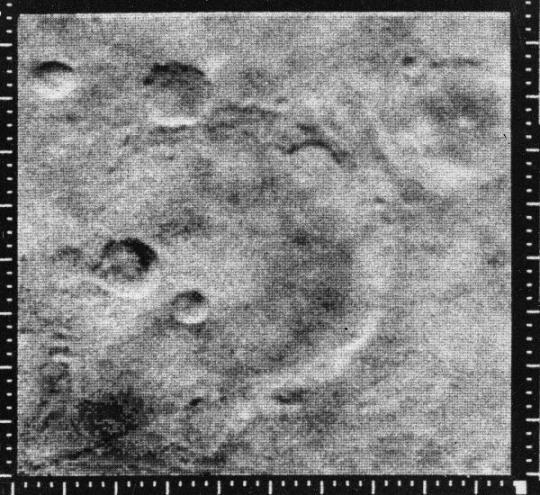
The pictures, played back from a small tape recorder over a long period, showed lunar-type impact craters (just beginning to be photographed at close range from the Moon), some of them touched with frost in the chill Martian evening.
Mariner 5

The Mariner 5 spacecraft was launched to Venus on June 14, 1967, and arrived in the vicinity of the planet in October 1967. It carried a complement of experiments to probe Venus' atmosphere with radio waves, scan its brightness in ultraviolet light, and sample the solar particles and magnetic field fluctuations above the planet.
Mariners 6 and 7
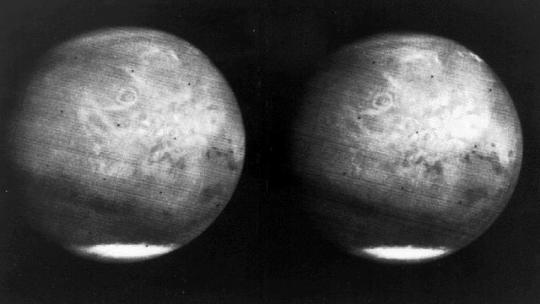
Mariners 6 and 7 were identical teammates in a two-spacecraft mission to Mars. Mariner 6 was launched on February 24, 1969, followed by Mariner 7 on March 21, 1969. They flew over the equator and southern hemisphere of the planet Mars.
Mariners 8 and 9

Mariner 8 and Mariner 9 were identical sister craft designed to map the Martian surface simultaneously, but Mariner 8 was lost in a launch vehicle failure. Mariner 9 was launched in May 1971 and became the first artificial satellite of Mars.
Mariner 10

The Mariner 10 spacecraft launched on November 3, 1973, and was the first to use a gravity assist trajectory, accelerating as it entered the gravitational influence of Venus, then being flung by the planet's gravity onto a slightly different course to reach Mercury. It was also the first spacecraft to encounter two planets at close range, and for 33 years the only spacecraft to photograph Mercury in closeup.

Venus in real colors, processed from clear and blue filtered Mariner 10 images

Mariner 10's photograph of Venus in ultraviolet light (photo color-enhanced to simulate Venus's natural color as the human eye would see it)
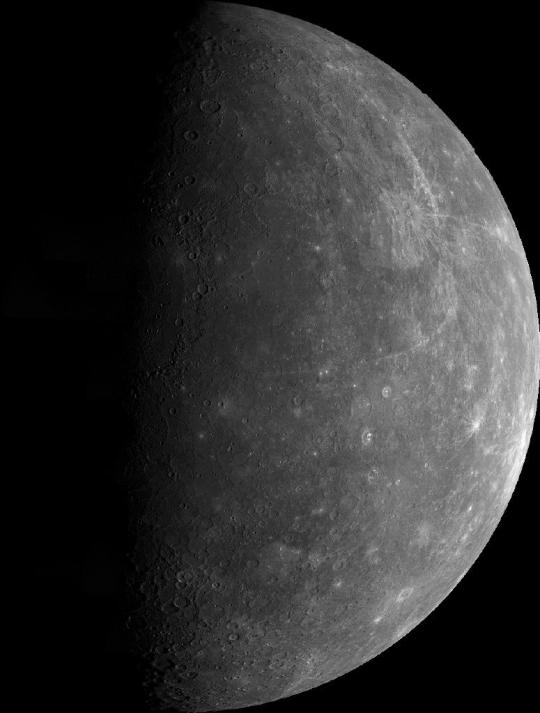
This mosaic shows the planet Mercury as seen by Mariner 10 as it sped away from the planet on March 29, 1974.
source x, x | images x
#mercurio#mercury#venus#mars#marte#astronomy#astronomia#space#solarsystem#sistemasolar#universe#universo#mariner#mission#space exploration
268 notes
·
View notes
Text

A modern Mellanoid Slime Worm spacecraft, the Ice Giants Explorer. Intended to launch in 2383, it ended up fast-tracked and launched under a completely different mission. It would have explored the four ice giants of the Zwo-Nmu system: Glarpi, Shpler, Euaua, and Flible, with a possible mission extension to distant, never-before-seen planet Schmidt. It's depicted here using its T.E.N.D.R.I.L. (Teleoperated extendible-node robotic interface limb) to deploy one of its many robotic probes to land on a small captured satellite of Shpler, S/2351 S2.
The spacecraft has two main propulsion systems, a fission-impulse drive and a pulsed warp engine. The fission-impulse drive are modified solid-core nuclear-thermal-rockets utilizing subspace field coils on the exhaust end similar to those utilized on starfleet impulse drives. However, the power generation for those impulse coils is provided by a fission reactor, instead of a fusion reactor. This results in approximately a doubling of the specific impulse of the engine while preserving thrust characteristics.
The pulsed warp engine uses a bank of high-density capacitors charged using the fission reactors, to provide short bursts of warp speed. Modern mellanoid transwarp coils can provide speeds of up to warp 5 on the new scale, but are bottlenecked by the power generation and storage rate. As such the pulsed warp drive technology is currently not usable for interstellar exploration, but it does allow for much faster intra-system manuevers. (The bright photon-wakes visible from many astronomical units away, and their associated radiation hazards, are considered an acceptable risk.)

#Mellanoid slime#mellanoid slime worldbuilding#spacecraft#spaceship#ice giant#uranus#neptune#saturn#ringed planet#planetary rings#captured satellited#planet art#space art#rocket#nuclear rocket#liquid droplet radiators
92 notes
·
View notes
Text
WHAT WILL IT TAKE TO REACH ZERO SPACE DEBRIS??
Blog#476
Saturday, February 1st, 2025.
Welcome back,
The space debris problem won’t solve itself. We’ve been kicking the can down the road for years as we continue launching more rockets and payloads into space. In the last couple of years, organizations—especially the European Space Association—have begun to address the problem more seriously.
Now they’re asking this question: What will it take to reach zero space debris?

At first glance, it may seem unreal, maybe naive. There are billions of pieces of space junk orbiting Earth, and more than 25,000 of those pieces are larger than 10 cm. Though small, these pieces are travelling fast and can cause significant damage when impacting satellites or space stations. What will it take to get rid of all this debris?
The ESA has released the Zero Debris Technical Booklet to elucidate the challenges to a zero-debris future and propose solutions to get there. The Booklet’s development follows the signing of the Zero Debris Charter by members of the Zero-Debris community.

“Despite several initiatives for space debris mitigation in recent years and modest improvements in public awareness, there is a general consensus that more ambitious actions are urgently needed from all space stakeholders to prevent, mitigate, and remediate debris,” the report states. The report points out that the Guidelines for the Long-term Sustainability of Outer Space Activities of the United Nations Committee on the Peaceful Uses of Outer Space outlines how access to space is hindered by debris.

The booklet defines zero debris targets and presents “technical needs, solutions and key enablers” that can help organizations achieve them.
The obvious first step is to cease creating more debris.
It begins with avoiding the unintentional release of debris. Exposure to the space environment can degrade materials during missions and beyond their end date, and unintentional impacts can also release debris. The Booklet promotes the “Development of multi-layer insulation and coating technologies preventing long-term degradation of materials” and similar developments for materials that can resist impacts. Improved monitoring, simulations, and testing can help us get there.

The Booklet also points out the need for different propulsion technologies. Some propulsion technologies release enormous quantities of small particles. The Booklet promotes the development of alternate propulsion systems based on things like electromagnetic tethers, momentum-transfer tethers, and drag or solar radiation pressure augmentation devices.
Originally published on https://www.universetoday.com
COMING UP!!
(Wednesday, February 5th, 2025)
"COULD HUMANS SURVIVE LIVING IN SPACE??"
#astronomy#outer space#alternate universe#astrophysics#universe#spacecraft#white universe#space#parallel universe#astrophotography
28 notes
·
View notes
Text
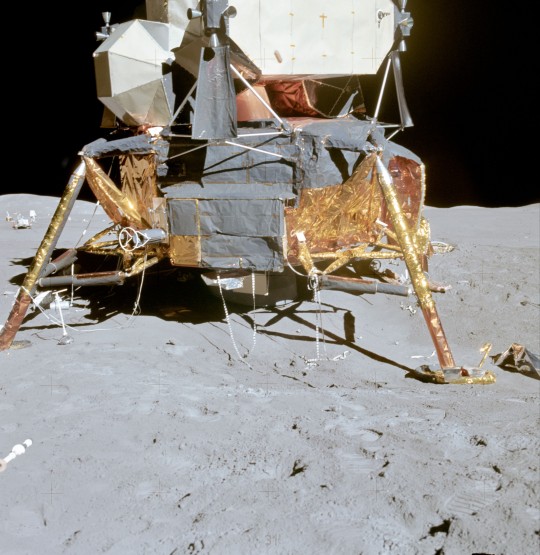
Southeast view of Apollo 15 Lunar Module (LM-10) Falcon, with the Lunar Roving Vehicle (LRV), Apollo Lunar Surface Experiments Package (ALSEP) and Hill 305 in the background. Photographed during the second Extravehicular Activity (EVA 2) of the Apollo 15 mission.


Decreased clearance led to buckling of the extended descent engine nozzle on the landing of Apollo 15.
"In order to extend landing payload weight and lunar surface stay times, the last three Apollo Lunar Modules were upgraded by adding a 10-inch (25 cm) nozzle extension to the engine to increase thrust. The nozzle exhaust bell, like the original, was designed to crush if it hit the surface. It never had during the first three landings, but did buckle on the first Extended landing, Apollo 15."
-information from Wikipedia: link
Date: August 1, 1971
NASA ID: AS15-87-11839, AS15-87-11842, AS15-88-11882
#Apollo 15#Lunar Module#LM-10#Falcon#NASA#Apollo Program#J-type mission#Moon Landing#Moon#Hadley–Apennine#Descent Propulsion System#Lunar Module Descent Engine#LMDE#Lunar descent stage propulsion#TRW VTR-10#Rocket Engine#August#1971#my post
35 notes
·
View notes
Text

8 Different Types of Helicopters and Their Uses
1. Single Rotor Helicopter:
A single-rotor helicopter has one main rotor for lift and thrust and a smaller tail rotor for counteracting torque. It is the most common design, known for simplicity and efficiency in most flight conditions. Examples include the Bell 206 and Robinson R44.
2. Tandem Rotor Helicopter:
Tandem rotor helicopters have two main rotors mounted at opposite fuselage ends, rotating in opposite directions to counteract torque. This design allows for a higher payload capacity. Examples include the CH-47 Chinook.
3. Coaxial Helicopter:
Coaxial helicopters have two main rotors mounted on the same axis but rotating in opposite directions. This eliminates the need for a tail rotor and improves stability, efficiency, and maneuverability. The Kamov Ka-52 is a well-known example.
4. Compound Helicopter:
Compound helicopters combine rotor systems with other propulsion methods, such as fixed wings or auxiliary propellers, to improve speed and efficiency. Examples include the Sikorsky X2 and Eurocopter X3.
5. Tilt Rotor Helicopter:
Tiltrotor aircraft can transition between vertical lift (like a helicopter) and forward flight (like an airplane) by tilting their rotors. They are faster and more versatile. The V-22 Osprey is a prominent example.
6. Intermeshing Rotor Helicopter:
These helicopters have two rotors that intermesh at an angle, eliminating the need for a tail rotor and providing excellent lift. The Kaman K-MAX is a key example.
7. Electric Helicopter:
Electric helicopters use electric motors powered by batteries, offering quieter operation and zero emissions. They are typically used for training or short-distance transport.
8. Military Attack Helicopter:
Designed for combat, these helicopters are heavily armed with missiles, rockets, and guns. They excel in ground attack and support roles. The AH-64 Apache is a leading example.
#helicopter#navy#air force#army#world war ii#aviacion#automotive#automobile#electric vehicles#aircraft#globe#steps
28 notes
·
View notes
Text
Humans Solve Problems With Explosions
Frank and Mel'iarr are sitting together in the common area of the Starbase, chatting. They have been fast friends ever since they were paired together on the Starbase Fire Brigade. Mel was fascinated about humans, and Frank was willing to indulge him when he asked questions... most of the time.
Mel'iarr puts down his tea. "Frank, the Humans have been in space a long time right?"
Frank nods and sips his cocoa. "That's what they tell us in school."
"So that means you've probably tried just about every method of propulsion in space, yeah?"
"Actually, yes! This was one of my favorite topics as a kid. I must have absorbed everything I could find about it."
"Oh, so you could talk to me about your historical propulsion systems! Do you mind if we talk about them?"
Frank looks at his friend, surprised. "I'd love to, but why?"
"To settle a bet." Mel'iarr picks up his chamomile tea and glances at it. With a flick of his ears - like a shrug - he tosses his tea back, finishing it. "You didn't jump to thrusters immediately and I know humans can be really inventive, so I assume you had some unusual ideas you tried out."
"Hmm. Okay, how about the Nuclear Salt Water Rocket?"
Mel'iarr chokes on his tea. Frank jumps up and pats his back. Mel holds up a hand and sputters. "The what?"
"Oh yeah, it's a great one! Take nuclear fuel, dissolve it in water, and then concentrate it to just under criticality - that's the point where fission takes place - and then squirt it into a chamber where it can achieve criticality and bam! Fission. Now, shoot that now superheated steam and heat from the reaction out the back, and you're making thrust."
Unconsciously, Mel'iarr leans back in his chair. "But, that's just sounds like a nuclear bomb that-"
"-That's going off all the time out the back yeah. Worked really well." As he talks, Frank becomes more animated. He's gesturing and his eyes are shining. Mel'iarr's tail flicks worriedly. "It was tough to get the pipes lined up correctly to not cause an early criticality incident, but we figured that out - mostly - before we started using them. Only a few blew up, but when they did, hoo boy. You could see it practically everywhere in the system."
Mel'iarr ears flatten. "Wow. Um, okay. That was a bit more... intense than I figured. Do you have another one that's less..." He thought for a moment. "Insane?"
Frank looks off into the middle distance. "Oh! I know one! It's an old one, but I always liked imaging using it. It's so old that it predates us leaving Earth entirely. An Orion Engine."
Mel'iarr relaxes. "That doesn't sound so-"
Franks gesturing nearly knocks over his cocoa. "I love this one, it's so simple and elegant. You just make hundreds and hundreds of small nuclear bombs, shoot them out the back one at a time, detonate them, and ride the pressure wave forward and repeat!"
Mel'iarr's fur poofs out angrily and his ears flick forward. "No. You're lying. You're just making that up."
"I'm not! Look!" Frank takes a moment to search on his pad, and brings up an archive video to show Mel.
While they're talking, Mel'iarr's other human friend, James walks by. James and Mel'iarr work together in Environmental Processing. With the Starbase's low population, Frank knows him too, but they're not especially good friends. Mel'iarr gestures to the human. "James! You have to help me!"
James looks down and the small, worried K'laxi. "Of course Mel, what is it? What's wrong?"
"Pen'men said that I couldn't find a problem that humans don't solve with explosions. I was speaking with Frank - from the Fire Brigade - and he started describing old human space propulsion systems that make me think that humans solve every problem with explosions."
James raised an eyebrow. "I mean space propulsion is by definition explosion based. That's a wild place to start, Mel. But okay, we can think of something." As they're thinking, Kerry walks by. She works in the infirmary and plays pickleball with James. "Kerry! Give me a problem that we don't solve with an explosion."
"Uh, a fire." Kerry offers.
Mel'iarr shakes his head sadly. "No, you've used explosions to blast oxidizer away from a fire, putting it out."
Kerry blinks, impressed. "Woah, neat! Hmm. cooking?"
Mel'iarr's ears droop. "There's a ancestors cursed grain that explodes when you cook it!"
"Oh popcorn, right." James sits down next to Frank and Mel and gestures for Kerry to join them.
"Oh! I've got one. Negotiation! Frank crosses his arms and looks satisfied.
Mel'iarr gives him a look. "I thought of that. What about intimidating the other side with an explosive based show of force?"
"Damn! I thought I had it there. Okay okay...." Frank picks up his cocoa, long gone cold, and takes a sip.
James casts his head around the room. "What about welding?"
"Welding?"
"Yeah, that's done with heat and electricity, but not explosions."
"I'm sorry James, I couldn't help overhearing." The Starbase AI cuts in "But humans have welded with explosions. It's a known method in welding two dissimilar metals in extreme environments."
Frank sits up and looks over at the Starbase interface screen. "Woah, really? That's so cool!"
"Frank, focus please." Mel'iarr says. "We're looking for non-explosive solutions."
"What about medical issues?" Kerry says. "There can't be a lot of call for explosions there."
Frank nods. "Hmm, now we might be onto something. What do you think Starbase?"
"Searching."
A moment goes by and Mel'iarr allows himself a moment's hope that he has finally found a solution that doesn't involve explosions.
"Results found. Mel'iarr, the humans use Nitroglycerin - an explosive - to treat heart disease."
All of Mel'iarr's fur poofs out in surprise. "THEY DO WHAT?"
"It helps prevent chest pains as a result of heart disease according to my records."
Kerry holds up her hands. "Wait. Wait wait wait. If we're counting nitroglycerins then we have to count electricity which can be generated by explosions."
"How in the name of my Ancestors do you generate electricity from explosions? Mel'iarr slumps back into his chair, defeated.
"We don't as much now, but electricity is generated from spinning a magnetic field, right? We had reciprocating engines that worked off of the explosion of refined hydrocarbons for hundreds of years."
James looks at Mel and narrows his eyes. "How did you do it at first Mel? You can't tell me you never developed reciprocating engines."
Mel'iarr Looks up at James. "No, we did, but they're different, they use temperature differential. Starbase, what's the human word for them?"
"Stirling engines, Mel'iarr. Humans did develop them, but they decided that the exploding way was preferable."
Mel'iarr puts his head in his hands. "I don't know what's worse! That you have an exploding solution to every problem or that you both think they're all really neat!
"I can't help it Mel'iarr, explosions are cool." James looks kindly at his friend.
Kerry agrees. "It's probably why it's used as a solution so often."
After the evening meal on that same day, Mel'iarr walks over to Pen'men while she's on her shift in Traffic Control, and silently hands her some currency.
Pen'men looks up from her console and stares at Mel'iarr.
Mel'iarr shakes his head. "You were right. They solve every problem with explosions."
"Told you."
#humans are deathworlders#humans are space orcs#writing#sci fi writing#humans are space capybaras#humans are space oddities#humans and aliens#the k'laxiverse#humans solve problems with explosions#jpitha
378 notes
·
View notes
Text


Can Life Exist on an Icy Moon? NASA’s Europa Clipper Aims to Find Out
With a spacecraft launching soon, the mission will try to answer the question of whether there are ingredients suitable for life in the ocean below Europa’s icy crust.
Deep down, in an ocean beneath its ice shell, Jupiter’s moon Europa might be temperate and nutrient-rich, an ideal environment for some form of life — what scientists would call “habitable.” NASA’s Europa Clipper mission aims to find out.
NASA now is targeting launch no earlier than Monday, Oct. 14, on a SpaceX Falcon Heavy rocket from Launch Complex 39A at NASA’s Kennedy Space Center in Florida.
Europa Clipper’s elongated, looping orbit around Jupiter will minimize the spacecraft’s exposure to intense radiation while allowing it to dive in for close passes by Europa. Using a formidable array of instruments for each of the mission’s 49 flybys, scientists will be able to “see” how thick the moon’s icy shell is and gain a deeper understanding of the vast ocean beneath. They’ll inventory material on the surface that might have come up from below, search for the fingerprints of organic compounds that form life’s building blocks, and sample any gases ejected from the moon for evidence of habitability.
Mission scientists will analyze the results, probing beneath the moon’s frozen shell for signs of a water world capable of supporting life.
“It’s important to us to paint a picture of what that alien ocean is like — the kind of chemistry or even biochemistry that could be happening there,” said Morgan Cable, an astrobiologist and member of the Europa Clipper science team at NASA’s Jet Propulsion Laboratory in Southern California, which manages the mission.
Ice Investigation
Central to that work is hunting for the types of salts, ices, and organic material that make up the key ingredients of a habitable world. That’s where an imager called MISE (Mapping Imaging Spectrometer for Europa) comes in. Operating in the infrared, the spacecraft’s MISE divides reflected light into various wavelengths to identify the corresponding atoms and molecules.
The mission will also try to locate potential hot spots near Europa’s surface, where plumes could bring deep ocean material closer to the surface, using an instrument called E-THEMIS (Europa Thermal Emission Imaging System), which also operates in the infrared.
Capturing sharply detailed pictures of Europa’s surface with both a narrow and a wide-image camera is the task of the EIS (Europa Imaging System). “The EIS imagers will give us incredibly high-resolution images to understand how Europa’s surface evolved and is continuing to change,” Cable said.
Gases and Grains
NASA’s Cassini mission spotted a giant plume of water vapor erupting from multiple jets near the south pole of Saturn’s ice-covered moon Enceladus. Europa may also emit misty plumes of water, pulled from its ocean or reservoirs in its shell. Europa Clipper’s instrument called Europa-UVS (Europa Ultraviolet Spectrograph) will search for plumes and can study any material that might be venting into space.
Whether or not Europa has plumes, the spacecraft carries two instruments to analyze the small amount of gas and dust particles ejected from the moon’s surface by impacts with micrometeorites and high-energy particles: MASPEX (MAss SPectrometer for Planetary EXploration/Europa) and SUDA (SUrface Dust Analyzer) will capture the tiny pieces of material ejected from the surface, turning them into charged particles to reveal their composition.
“The spacecraft will study gas and grains coming off Europa by sticking out its tongue and tasting those grains, breathing in those gases,” said Cable.
Inside and Out
The mission will look at Europa’s external and internal structure in various ways, too, because both have far-reaching implications for the moon’s habitability.
To gain insights into the ice shell’s thickness and the ocean’s existence, along with its depth and salinity, the mission will measure the moon’s induced magnetic field with the ECM (Europa Clipper Magnetometer) and combine that data with measurements of electrical currents from charged particles flowing around Europa — data provided by PIMS (Plasma Instrument for Magnetic Sounding).
In addition, scientists will look for details on everything from the presence of the ocean to the structure and topography of the ice using REASON (Radar for Europa Assessment and Sounding to Near-surface), which will peer up to 18 miles (29 kilometers) into the shell — itself a potentially habitable environment. Measuring the changes that Europa’s gravity causes in radio signals should help nail down ice thickness and ocean depth.
“Non-icy materials on the surface could get moved into deep interior pockets of briny water within the icy shell,” said Steve Vance, an astrobiologist and geophysicist who also is a member of the Europa Clipper science team at JPL. “Some might be large enough to be considered lakes, or at least ponds.”
Using the data gathered to inform extensive computer modeling of Europa’s interior structure also could reveal the ocean’s composition and allow estimates of its temperature profile, Vance said.
Whatever conditions are discovered, the findings will open a new chapter in the search for life beyond Earth. “It’s almost certain Europa Clipper will raise as many questions or more than it answers — a whole different class than the ones we’ve been thinking of for the last 25 years,” Vance said.
TOP IMAGE: This artist’s concept (not to scale) depicts what Europa’s internal structure could look like: an outer shell of ice, perhaps with plumes of material venting from beneath the surface; a deep, global layer of liquid water; and a rocky interior, potentially with hydrothermal vents on the seafloor. Credit: NASA/JPL-Caltech
LOWER IMAGE: The puzzling surface of Jupiter’s icy moon Europa looms large in this reprocessed color view made from images taken by NASA’s Galileo spacecraft in the late 1990s. The images were assembled into a realistic color view of the surface that approximates how Europa would appear to the human eye. Credit: NASA/JPL-Caltech/SETI Institute
41 notes
·
View notes
Text
New metal-plasma rocket thruster

Looking for near-future tech to supply perpetual power for your story's space colony? This looks promising!
Magdrive, a space-tech startup, has developed a new kind of plasma thruster that can use any metal, including iron, as a fuel source. Spacecraft using the new thruster could refuel on the hop by mining asteroids, providing near-infinite ranges if deployed.
The new Super Magdrive rocket uses metal ions to drive spacecraft forward. Solar power charges its capacitors, ionizing any metal as raw material for its tiny thruster bullets.
Best of all, Magdrive claims it generates thrust an order of magnitude higher than similarly sized electric propulsion systems currently used for long-range space thrusters (ion rockets), and was successfully tested in January 2023.
more info: X
Magdrive website: X
23 notes
·
View notes